Kyoto is one of those cities that is enchanting any time of the year. We’ve loved going back again and again and seeing how the temple gardens and vibe of the place changes between seasons.
Get ready to find out about the city’s coolest festivals, the secrets to a successful Sakura season holiday, and all the nitty gritty details you need to know about rainfall and average temperatures. It’s no fun arriving somewhere and realizing you’ve timed it wrong – which is why we’re here.
When you get to the point of wondering, when is the best time to go to Kyoto? This guide will help you plan that perfect trip!
What You’ll Get Out Of This Article
- Discover the best months to visit Kyoto for weather, festivals, and fewer crowds.
- Learn when the city hits peak beauty with cherry blossoms and autumn foliage—and when to avoid it.
- Get a clear breakdown of each season’s highs and lows so you can tailor your trip to your style.
- Understand how to time your visit to match your budget, comfort level, and travel goals.
Kyoto’s Travel Seasons
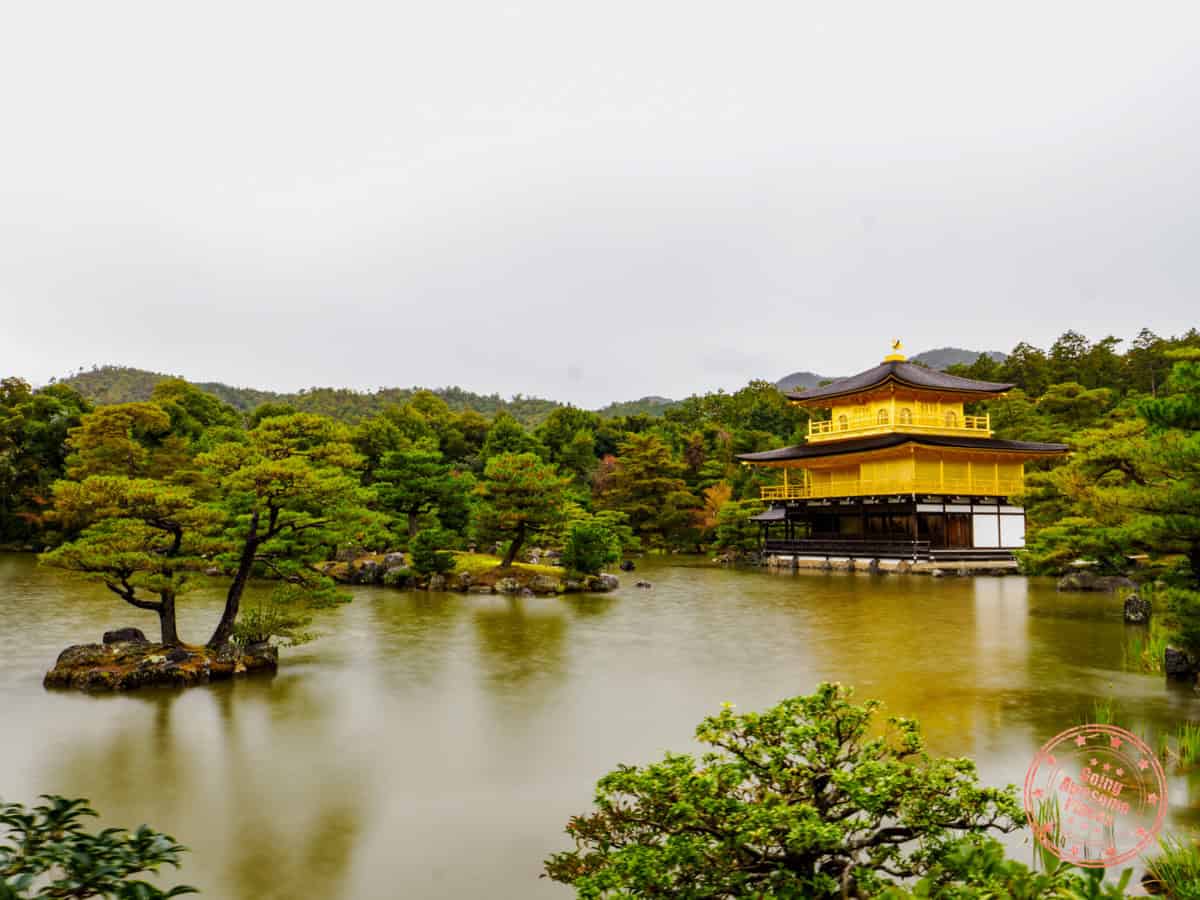
Kyoto is a city that experiences four distinct seasons. It goes from being warm and sunny in the summer months then drops to single figures during the winter.
TOP TIPS FOR TRAVELING TO KYOTO
- Where to stay: If you’re looking for a place that blends comfort with authentic Japanese charm, we highly recommend Ryokan Shimizu. It’s the perfect stay for travelers wanting a traditional tatami room experience while still being close to Kyoto Station—making it super convenient for exploring the city’s top temples, gardens, and neighborhoods. We use Booking.com or Agoda.com for all of our Japan stays and use the Genius discount to get great deals on our hotel bookings. Alternatively, you can always see if hotel corporate codes might work for you.
- Must pack item: A comfortable pair of walking shoes is an absolute must-pack item for Kyoto. With so many temples, gardens, and scenic streets to explore on foot, you’ll easily hit your step count each day!
- Car rentals – If you’re staying within Kyoto, we actually don’t recommend renting a car. Just take the bullet train to get around instead. If you do need a car, make sure to make use of our car rental coupon codes and compare against Discover Cars and RentalCars.
- Flights – If you are flying in from elsewhere use the Skyscanner “Everywhere” feature to find the best deals from your local airport. Check how much it would be for you to get to Kyoto!
- Insurance – Not always required but always recommended! Make sure you’re covered with the best travel insurance. Our go to is always HeyMondo.
- Hottest deals – Never be without our frequently updated travel deals page.
It’s worth having some sense of what you want to do during your visit to Kyoto, so you can decide which season will suit your itinerary the best!
Winter – Off-Peak Season

Months: December to February
To give you a rough idea, winter (December to February) is mild with averages of around 10C/50F. Although don’t be surprised if December drops below 0C/32F, and January is typically the coldest month of the year, so it wouldn’t be our first pick for a sightseeing trip.
While winter isn’t the most popular time to visit Kyoto, it does have its quiet charms. Many of the city’s highlights, like strolling through the Higashiyama district and visiting its beautiful temples, are best enjoyed outdoors, which can be less pleasant in cold or wet weather.
Still, if you find yourself in Kyoto during the winter months, it’s an ideal opportunity to experience the city’s onsen culture. There’s nothing quite like soaking in a steaming hot spring while the air around you is crisp and cool.
If your visit falls in February, plan to witness Setsubun, a vibrant fire festival held at Yoshida Shrine from February 2nd to 4th.
The event features a dramatic bonfire and traditional Shinto rituals, including the famous oni-yarai bean-throwing ceremony meant to drive away evil spirits and invite good fortune for the year ahead. It’s an unforgettable glimpse into Kyoto’s deep-rooted traditions.
Spring – High Season
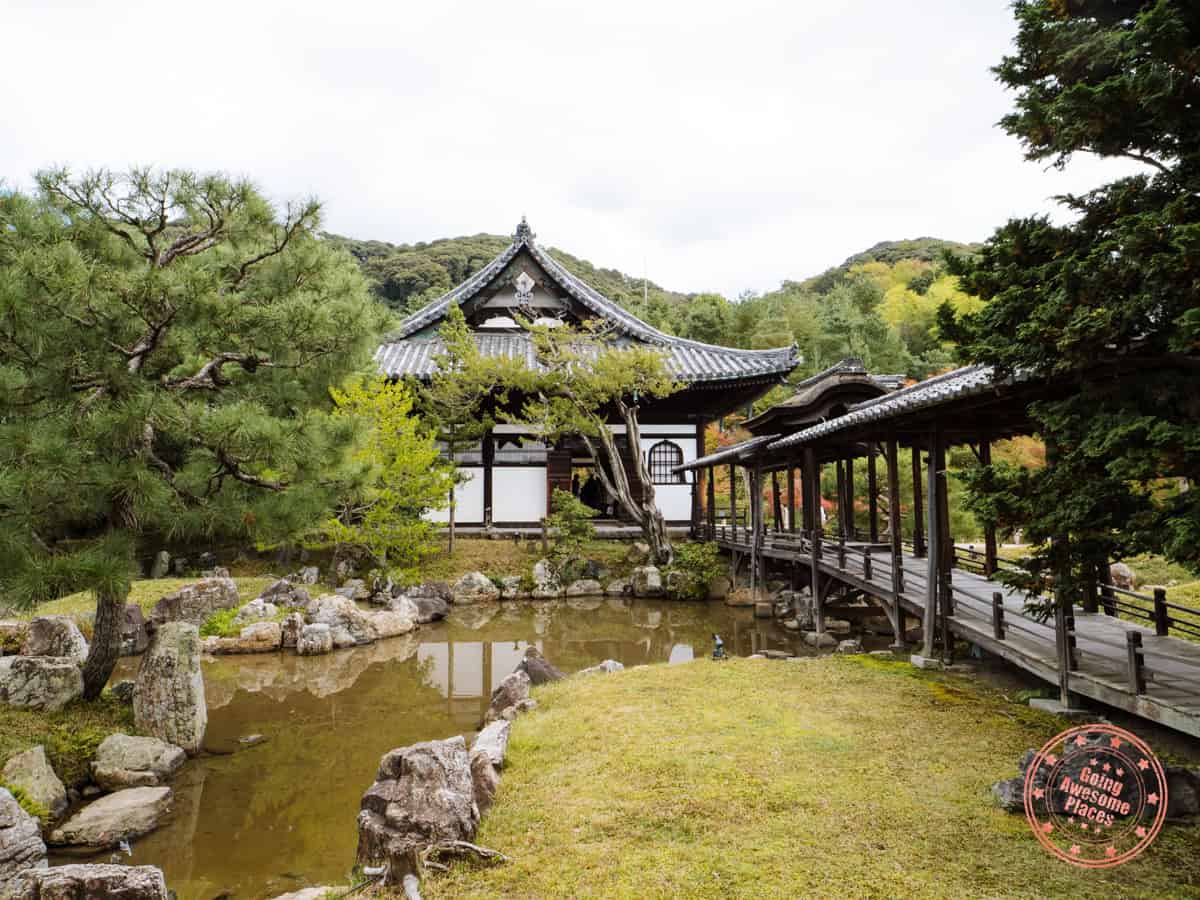
Months: March to May
Things begin to warm up as spring arrives (March to May). The temperatures in March average around 14C/57F, which is still pretty fresh but not freezing. By April, temperatures really start to go up, and it is without question the most magical time to visit Kyoto.
With the arrival of Spring, the city bursts into life for the Sakura season, the world-famous cherry blossom bloom that transforms Kyoto into a sea of soft pink. Witnessing the blossoms in person feels almost surreal.
When we visited the tranquil tsukiyama-style garden of Kodaiji Temple and saw the petals drifting gently through the air, it was a true bucket-list moment. You can read more about this beautiful Zen Buddhist temple in our Ultimate Kyoto 4 Day Itinerary.
If you’re planning your trip around the cherry blossoms, timing is everything. The Sakura season typically runs from late March to early April, but the exact peak bloom varies each year.
Our Ultimate Guide To Cherry Blossoms In Japan: Best Places & Peak Viewing Times includes helpful tips, such as using a Sakura forecast map, to make sure you catch the blossoms at their best.
There are no fixed dates you can circle on the calendar, but early April is generally a safe bet for peak bloom. Head to Maruyama Park, one of Kyoto’s most beloved cherry blossom spots, to experience the magic up close.
Cherry-blossom season is, without a doubt, what Kyoto is best known for; however, the blossoms are extremely fickle and can come out any time between late March and mid-April.
Looking for a festival you can go to in spring? Then check out Kyoto’s Golden Week which happens in late April to early May. It’s one of the busiest times of year in the city, so make sure you book everything in advance!
Several national holidays also take place over that week, so a lot of businesses aren’t open.
Over Golden Week there are lots of different parades and performances to see, like the Kamogawa Odori geisha shows and the Shimogami-jinja horseback archery.
Learn everything you need to know about Sakura Season in Japan, including best viewing times and locations!
The Ultimate Guide To Cherry Blossoms In Japan: Best Places & Peak Viewing Times
Summer – Festival Season

Months: June to August
After that, we reach summer (June to August), which is hot, hot, hot! Daily temperatures average around 28C/82F, so bring along plenty of sunscreen and your lightest clothes.
You’d think that, based on how hot it can get, summer would be a good time for sightseeing in Kyoto, but actually, the end of June marks the start of the city’s rainy season. Because of this expect the humidity to be pretty high.
During the summer it can be hot and sunny one minute and then raining the next. We’re not massive fans of the weather being unpredictable, so we chose not to visit in summer, but if you’re hoping to save a bit of money on your trip then it can be a good time of year to visit.
There are fewer tourists at this time of year, so the prices of flights and hotels drop in comparison to spring.
On a hot summer day, the Arashiyama Bamboo Grove is a cool place you can hide away from the heat. The bamboo tunnels are super impressive. Remember to get there early in the morning if you want to beat the crowds.
There are a few festivals worth going to in the summer if you are prepared to face the heat. In July, there’s the Gion Matsuri festival, which is ranked as one of the top three festivals in Japan; so don’t miss it!
Three evenings before the main parade, the streets of downtown are closed off to traffic, and locals party among decorated floats while dressed in yakuta (cotton robes). All of this culminates in a huge float parade on July 17th.
Another summer celebration worth checking out is on August 16th. The hillside surrounding Kyoto is set ablaze in shapes of ideograms for the Daimon-ji Fire Festival. It is a crazy concept, and we’ve never seen anything like it anywhere else. The festival is also known as the Obon Festival.
We weren’t really sure what the meaning of the bonfires were, but when speaking to some locals, they told us about how the five massive bonfires, each the shape of a kanji character, drive the ancestral spirits back to the spirit world. We’re not sure how much we believe in free-roaming spirits, but it’s a cool concept!
Fall – Peak Season
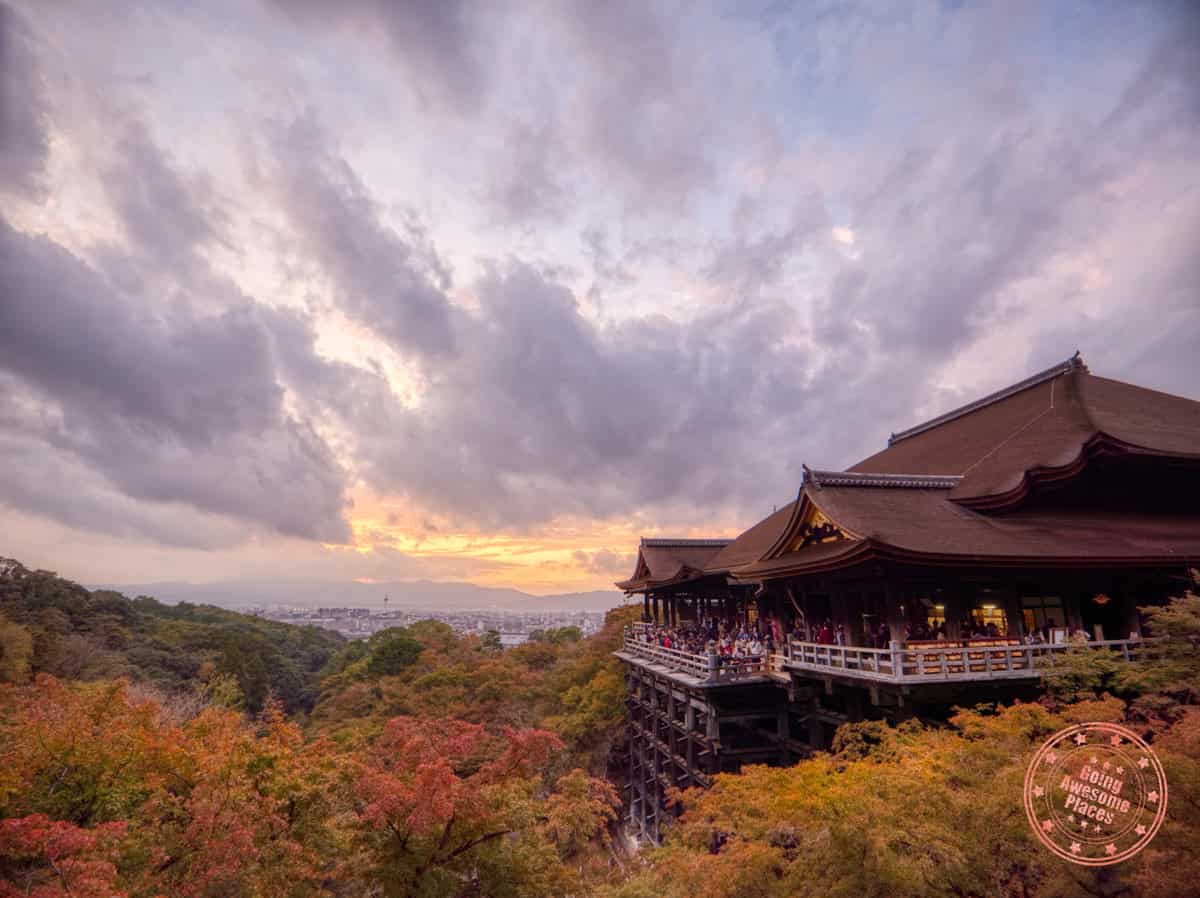
Months: September to November
After that we’re into September, which marks the start of autumn (September to November) and a dramatic end to the rainy season. Temperatures start to taper off, dropping from the high twenties in the height of summer down to 17C/62F.
Autumn is a popular time of year to visit Kyoto as it’s when the autumn leaves start to appear. The city’s parks become a photographer’s dream as they turn hues of red, orange, and yellow.
Because it’s less rainy than the summer, it’s also a good time of year to go sightseeing. Make sure you put places like the Kiyomizu-dera Temple at the top of your bucket list!
Visiting Kyoto in autumn? Don’t panic, we’ve got some festivals in store for you too. On the evening of October 22nd, the Kurama Fire Festival is in full swing in the mountain town of Kurama, just outside of the city.
The town transforms into a spectacle, with villagers walking around carrying giant flaming pine torches called taimatsu. There’s also an impressive procession of portable shrines that are really special to witness.
Coincidentally, on the very same day in Kyoto, the Jidai Matsuri, or Festival of the Ages, is on. This is where there are parades showing off the elaborate clothing that has been worn in Japan throughout history, and people are dressed as historical figures from the Heian period right up to the Meiji Restoration.
The only drawback of visiting in autumn is that it is very popular, which can push hotel and flight prices up.
Typhoon Season

Months: May to October
Another thing that’s worth mentioning is that Japan can be affected by typhoons, which tend to hit the country between May and October, with September and August being peak typhoon season.
If the typhoon is bad, then it can mean the city’s public transport and even flights in and out of Kyoto come to a standstill.
Being drenched by torrential rain and having to hide away from the weather in your hotel room is no one’s holiday dream, so we’d recommend keeping an eye on weather predictions ahead of your trip.
We’d also recommend always having an umbrella and some waterproofs with you, just in case!
Best Time To Visit Kyoto

It’s no surprise that the most popular times to visit Kyoto are also when the weather is at its best. After all, who wants to spend their holiday getting drenched in the rain or putting on endless layers to try and fend off the cold? Not us, that’s for sure!
March to May are fantastic months weather-wise, things are starting to warm up after the cold winter, and the temperatures are warm but comfortable. You also get the sakura season midway through the spring, which is a once-in-a-lifetime experience.
The only drawback is that prices tend to skyrocket this time of year because it’s such a popular time to visit. You definitely won’t have the city to yourself, that’s for sure.
The Cherry Blossom Festival offers a compelling reason to visit Kyoto in April, but keep in mind that the city becomes crowded with domestic and international tourists during this time.
October and November, during the autumn season, are equally desirable. It’s sunny and warm during the day, but then the evenings are refreshingly cool. Make sure you pack a cozy jacket!
There aren’t as many festivals in autumn, but it’s made up for by the fall colors that bring Kyoto to life.
But like in spring, keep in mind that the picturesque autumn foliage attracts a high turnout of tourists. To save yourself potential disappointment, make sure you book your accommodations well in advance if you’re visiting in autumn, and be prepared to pay a little more than you would in the winter and summer months.
If we were to pick two of the best months to go to Kyoto, we’d say March and September.
Both early to mid-March and late September get you into Tokyo before the start of peak travel season, which means you’ll be able to enjoy the benefits of fantastic weather without the massive crowds. Going at the tail end of the low season also means that you can find hotels at a bargain price.
What Not To Miss In Each Season
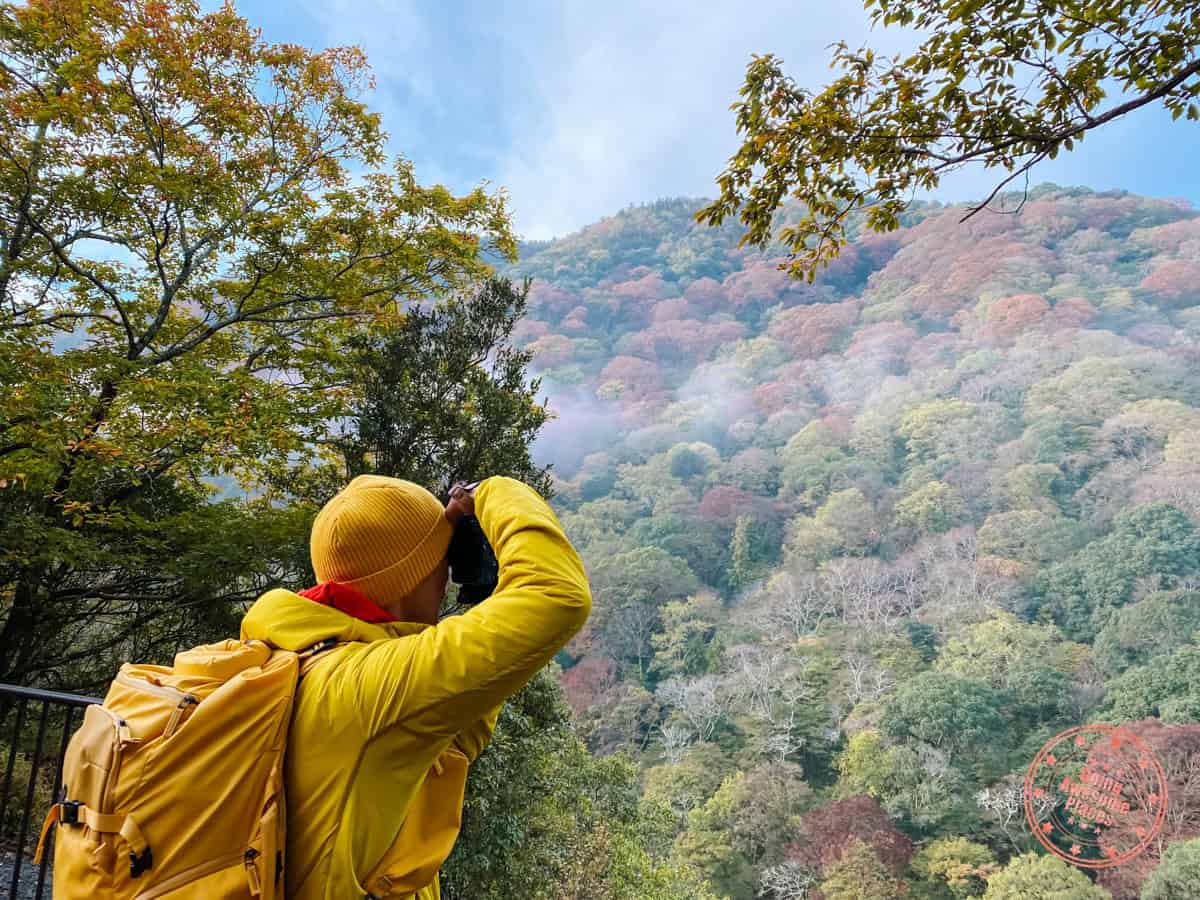
Every season has its charm in Kyoto, but here are some of the things you can’t miss!
- Winter – The cold makes sightseeing less fun in the winter months, but it is the perfect time of year to chill in the city’s onsens. Make sure you catch the Setsubun festival on your visit. One perk is that flights and hotels are super cheap this time of year.
- Spring – If you haven’t seen Japan’s cherry blossom trees before, come for the Sakura season. The city’s temple parks are decorated with a sea of pink petals that will leave you in awe.
- Summer – Kyoto’s summer months are packed with cool cultural festivals. Dive into the country’s history and discover the epic traditions that are still going strong today at the Gion Matsuri festival and the Daimon-ji Fire Festival.
- Autumn – The autumn foliage in Kyoto is a photographer’s dream. There are also a few festivals worth adding to your itinerary, like the Kurama Fire Festival and Jidai Matsuri.
What Not To Miss In Kyoto
Find out everything we loved experiencing during our time in Kyoto!
Immerse Yourself in Japanese Culture in Kyoto
Worst Time To Visit Kyoto
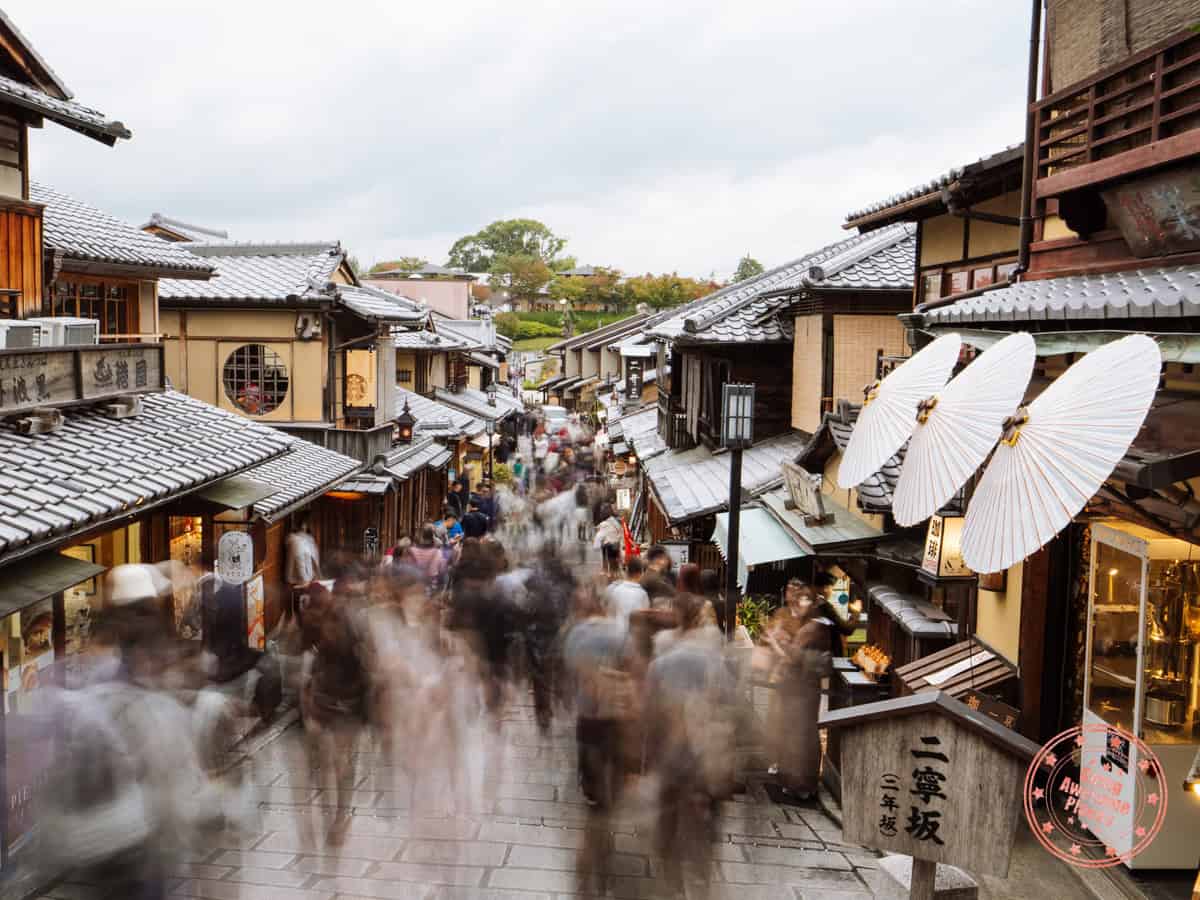
Now you’ve got a good idea of when you should visit Kyoto, let’s take a closer look at the worst times to visit.
- If you hate crowds – Spring and autumn are disastrous in Japan if you’re not a fan of crowds. People from all over the world flock in to see the cherry trees in all their glory in the spring months, and then again in the autumn when the red and orange foliage makes the city extra pretty.
- If you don’t like cold weather – Winter can be chilly in Kyoto, so avoid coming in the winter if you’re hoping to explore the city without a massive jacket on!
- If you don’t like hot weather – One thing that’s nice about Kyoto is that it never gets overbearingly hot. The summer months are hot, but you can still get out and do things in the city.
- If you’re on a budget – Broke backpackers definitely won’t love the hotel and flight prices on offer in spring and autumn. You might have to miss out on seeing the Sakura season this time round and visit in the summer months if you’re on a tight budget.
Kyoto Weather By Season
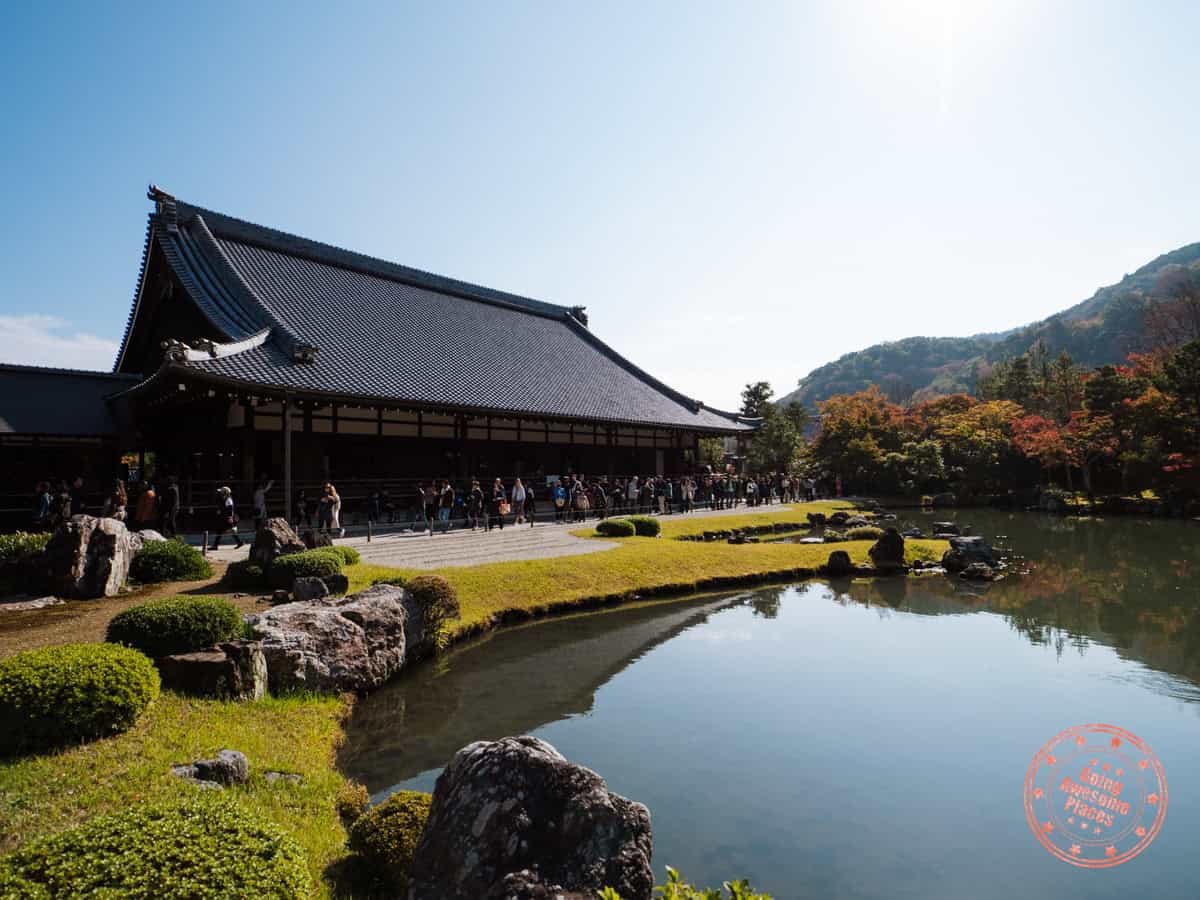
We want to make sure you’re armed with all the information you’ll need, so we’re diving even deeper.
Our season-by-season weather breakdown has everything you need to know about the average temperatures in each season, rainfall, and some handy stuff on typhoons and tsunamis. Ever heard of the Ring of Fire?
Tokyo Weather Charts
| Average Temperature | Average Rainfall | |
| Winter | 1.4°C / 34.5°F | 71 mm |
| Spring | 19.2°C / 66.6°F | 140 mm |
| Summer | 30.3°C / 86.5°F | 240 mm |
| Autumn | 20.4°C / 67°F | 120 mm |
Winter
Winter is cold in Kyoto. It rarely drops below freezing, but on colder days, average temperatures sit around 1.4°C / 34.5°F. Even on a good day, it doesn’t get much warmer than 9.7°C / 49.5°F. We never left the hotel without a warm coat and a good base layer on!
The nice thing about winter is that you do get a lot of clear days. You’ll be surprised to know that winter is actually the driest season in Kyoto! It’s not necessarily that there are less days of rain in the winter months compared to the city’s wet summer months, but the precipitation levels are about a quarter.
That means that even if there are 18 days of rain on average in December, there’ll only be about 71 mm of rainfall over the course of the month (compared to about 240 mm of rainfall in July).
Spring
Spring is generally quite mild in Kyoto. On warmer days, temperatures sit around 19.2°C / 66.6°F, though the average lows this time of year oscillate around 7.8°C / 46°F. Make sure you pack some warm layers as the temperatures drop quickly once the sun has gone down!
If you’re lucky, you won’t see much rain, though it is wetter than winter. March is rainier than April and May, so if you’re visiting Kyoto for the Sakura season, then coming at the tail end of March and beginning of April is a pretty good shout. You can expect to see around 140 mm of rainfall per month in spring.
Summer
Summers are pretty hot and humid in Kyoto thanks to the tropical currents that swoop over Honshu Island. You get freakishly hot days, but average highs sit around 30.3°C / 86.5°F. It does get cooler in the evenings, and you get plenty of rainy and cloudy days, but even then, it doesn’t drop much below about 21.4°C / 71.52°F.
The thing you want to watch out for when you’re planning a summer trip is the monsoons. Known as the tsuyu season, the monsoons hit Kyoto in early June to mid-July. The whole of summer is also within the typhoon season. The city usually gets hit by typhoons from May to October, when strong winds and heavy rains aren’t uncommon.
June and July are the rainiest months of the year in Kyoto. There are around 18 days of rain in June and July, with around 240 mm of rainfall, which is a lot! Make sure you pack a good-quality raincoat and an umbrella if you’re visiting in summer.
By contrast, August is the hottest and driest month of the year. The rain clears, and the temperatures rise almost out of nowhere.
Autumn
On sunnier days, temperatures oscillate around 20.4°C / 67°F in autumn, though of course it gets colder the closer you get to winter. We found that a good jumper and a light coat were enough to keep us warm in the autumn months.
Evenings are much cooler, and there are days when the wind is brisk and averages were more like 12.8°C / 55°F.
September is the rainiest month in autumn, then it gets drier again in October and November. Precipitation levels are pretty low this time of year, and average around 120 mm of rain per month.
We’d still recommend bringing a waterproof jacket along, as that translates to a light rain 15 days each month! Bear in mind that autumn is within the typhoon season, from May to October, so there’s a risk of the winds picking up and you being hit by a heavy downpour.
Japan’s Ring Of Fire – Is The Next Big Earthquake Coming?

Loads of Japan’s coolest things, like the volcanoes and onsens, are thanks to the fact that it sits along the Ring of Fire. Essentially, Japan’s islands are right where four tectonic plates – the Pacific, Philippine Sea, Eurasian, and Okhotsk – converge.
That means that there’s always more risk of earthquakes and tsunamis in Japan than other places in the world. There have been rumors that a mega-earthquake was soon to hit the island – but there’s a lot of skepticism as to whether or not that’s true.
Special Holidays, Festivals & Events In Kyoto

There’s always something going on in Kyoto, so to help you find your feet, here’s a list of all the biggest festivals and holidays that you should keep an eye out for:
- February – The Setsubun bean-throwing rituals happen across Kyoto’s temples in February. It’s awesome to see, although there aren’t any giant parades like at the bigger festivals.
- Late April and early May – Kyoto’s Golden Week is spread across April and May. Each day there is a different schedule of events and parades happening. It happens across the country, but Kyoto’s is extra cool!
- July – One of Japan’s biggest (and best) festivals is in July. The epic Gion Matsuri festival takes over the city for pretty much the entire month. There are floats, processions, and night parades that all revolve around the Yasaka Shrine.
- August – The mountains surrounding Kyoto are decorated with giant idiograms that are set on fire and illuminate the city on the 16th of August, the day of the dramatic Daimon-ji Fire Festival.
- October – If you can make it out for the Kurama Fire Festival on the 22nd of October, you’ll have a blast. We haven’t seen anything like it anywhere else. The festival is in the town of Kurama just outside of Kyoto, but the fire processions are worth traveling for.
- On the very same day in the city itself, there’s the Jidai Matsuri (Festival of the Ages) parade, when you’ll see loads of people dressed in historical costumes
Where Are The Best Places To Stay In Kyoto?
Regardless of when you decide to go, make sure you do your research to find a place to stay that not only has good prices but is also located in a cool neighborhood or near most of the attractions you want to explore during your Kyoto adventures.
Finding great accommodations in Kyoto isn’t easy, as places can get expensive. If you’re looking to stay in a traditional Japanese accommodation so you can have an authentic experience and give living like a local a go, then make sure you check out our guide to the Best Budget Ryokans in Kyoto.
Like we said, getting the neighborhood right is half the battle. It can be difficult to know just from online research whether you’ll like the vibe of an area. We experienced that firsthand on our first visit to Kyoto, when we felt that where we were was fine, but not quite right.
To save you from making the same mistake, we’ve put together a full neighborhood breakdown to help you decide Where To Stay in Kyoto.
If you don’t have enough time on your hands to read our longer guides, then here’s a sneak peek of our favorite places to stay:
BEST OVERALL RYOKAN

Ryokan Shimizu
While this might not be the fanciest ryokan out there, on balance of the price, the staff, the rooms, and amenities, we were very happy with our stay here the last time we were in Kyoto. It’s budget-friendly, comfortable, and feels local.
BEST BUDGET HOTEL

Laon Inn Gion Shinmonzen
A highly rated property in the Gion area of Kyoto that is under $100 (which is very reasonable!). Don’t let the price fool you; it is a fantastic and well-respected property in Kyoto.
MID-RANGE

RC Hotel Kyoto Yasaka
This modern and luxurious hotel comes with epic mountain views. There’s an attention to detail throughout the hotel that is above what you would find in many places, and it had everything we needed for a short stay.
BUDGET

Kamoya Ryokan
We loved how traditional this ryokan was, and the hosts were so friendly. The tatami flooring, low tables for tea ceremonies, and Japanese decor made it feel really authentic and cozy.
More On Where To Stay In Kyoto
Take a deeper dive into places we recommend staying when in Kyoto from firsthand experience!
Where to Stay in Kyoto, Japan – A Guide To The Best Hotels, Ryokans, and Neighbourhoods
Kyoto Travel Tips
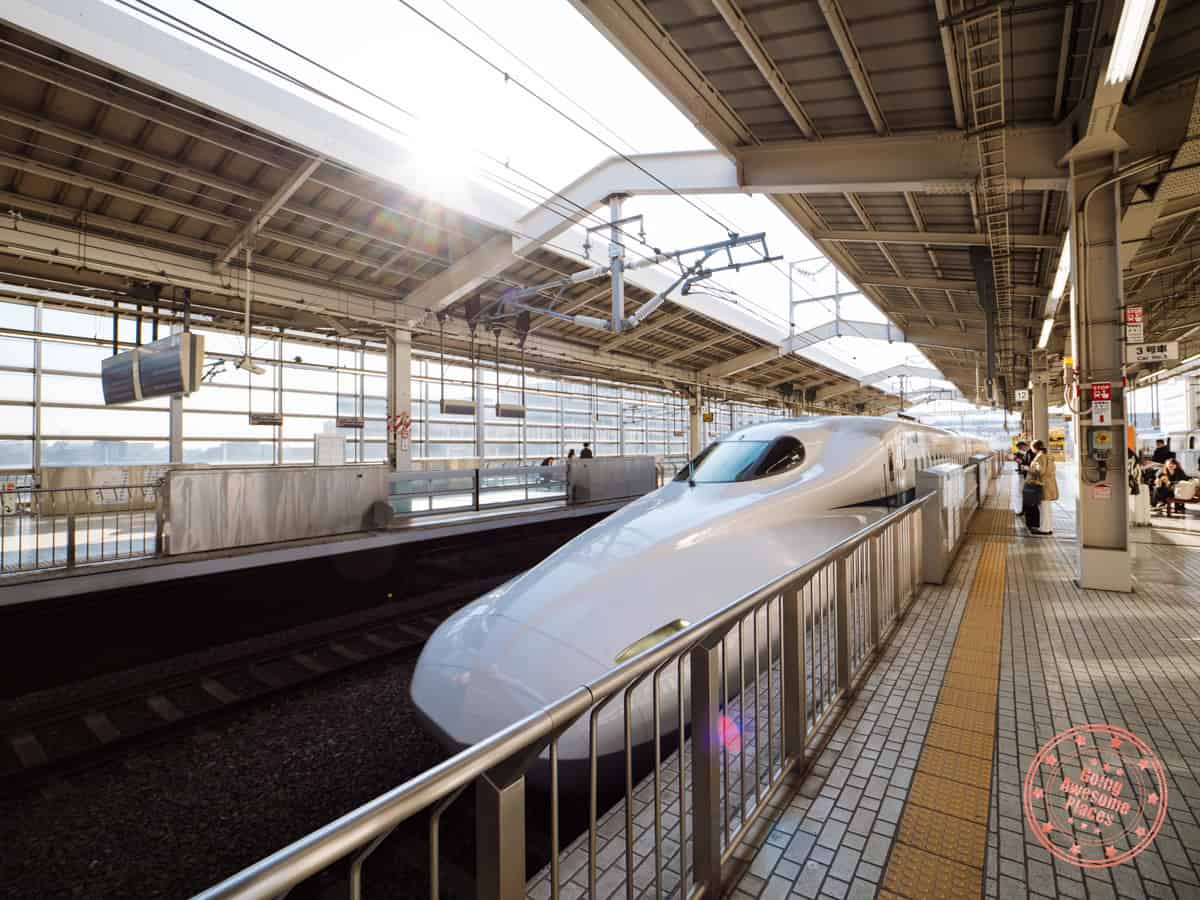
Get your hands on a JR Pass: If you’re looking to do any traveling around Japan, even if you’re only going to venture out of the city to go to the nearby Osaka, we highly recommend picking up a JRailPass. Keep in mind that you’ll need to purchase it before your trip and have it sent to you at home before you leave for your trip.
Do you need a JR Pass?
If you’re looking to do any travelling around Japan, I highly recommend picking up a JRailPass. Keep in mind that you’ll need to purchase it before your trip and ship it to your home.

You’ll need to carry your trash: There aren’t many trash cans dotted around the city in Kyoto, and littering is a definite no-go. Bring along a plastic bag or something that you can put your trash into, then keep it in your backpack until you can dispose of it properly.
Remember that they don’t tip in Japan: As people who are used to tipping, we were really confused when the waiters kept giving us back the tips we’d left them. Turns out Japan doesn’t have a tipping culture.
Get a pocket Wi-Fi: Being able to stay connected while you’re abroad and having a solid connection so you can use tools like language translators is always helpful. You can get your hands on the local PUPURU pocket WiFi at the airport, then drop it back off there, or use Skyroam, which is our favorite. It’s so great that we even reviewed it in our Review: Skyroam Solis Portable Wifi Hotspot Device guide.
Your Go-To Japan Trip Planning Resources
Are you in the process of planning your once-in-a-lifetime trip to Japan? Here are a few handy guides and inspiring itinerary articles that you’ll want to read or bookmark before you go.
- Ultimate Kyoto 4 Day Itinerary: This awesome four-day itinerary has a day-by-day breakdown of things to do in the city. Each day has a slightly different theme, so you can pick and choose or even skip days if you’re short on time. We’ve included everything from where to stay to the best transport options between attractions. Fair to say it’s our best Kyoto guide yet!
- Where To Stay In Kyoto – A Neighborhood Guide: Deciding where to stay is one of the hardest parts about planning a trip. What if you pick the wrong neighborhood and have to travel for ages to get to the attractions you want to see? Or worse still, what if you’re hotel is nothing like what you expected? We know how stressful it can be, so we’ve put together this handy neighborhood guide, which includes the best accommodation in each area to help you out!
- 12 Day Japan Itinerary: This 12-day itinerary covers much more than just Kyoto, but you can skip the other sections or use them as inspiration if you’re planning a longer trip to Japan.
- Guide To The Must-Try Food In Osaka: If you’re already in Kyoto, then it makes sense to hop over to Osaka, which is a short train ride away. There’s loads to do in the city and you’ll need to fuel up in between sightseeing. This guide is great for foodies!
- Immerse Yourself In Japanese Culture In Kyoto: Kyoto is a charming historical city that is rich in traditions. It’s obvious from the moment you arrive in the Higashiyama neighborhood and see geishas wandering around the cobbled streets that this is a city for culture fanatics.
- Best budget ryokans in Kyoto: This is another great article to check out if you’re struggling to know where to stay, especially if you’re traveling on a budget or you want to experience living like a local.
- Japan Travel Guide: Find out everything you need to know about Japan, from the local currency to handy tips for getting around!
- Ultimate Guide To Cherry Blossoms In Japan: Best Places & Peak Viewing Times: Although this guide isn’t Kyoto specific, there’s loads of handy information about how to get your timing just right, so you catch the cherry blossom in full bloom and some insight on why the cherry tree is so important in Japanese culture.
Learn how to navigate around Kyoto, from where to stay, eat and everything else in this itinerary!
The Ultimate Kyoto 4 Day Itinerary
Looking For Other Things To Do In The City?
Kyoto Packing List
Packing for Kyoto depends a lot on when you visit. The city’s seasons can feel completely different from one another. Whether you’re wandering through cherry blossoms in spring, braving the summer heat, or layering up for crisp autumn strolls, having the right essentials can make all the difference. Here are our top packing picks to help you stay comfortable and prepared year-round.
- Comfortable walking shoes: Kyoto’s temples and historic streets mean lots of walking and uneven surfaces; you’ll thank yourself for wearing supportive shoes.
- Light jacket or sweater: Even during warmer seasons, mornings and evenings can get cool—layering keeps you comfortable through temple visits and evening strolls.
- Rain jacket or poncho: From summer showers to unexpected showers any time of year, staying dry makes sightseeing far more enjoyable.
- Modest clothing for temple visits: When visiting temples or shrines, shoulders and knees should be covered; a scarf or shawl can come in handy.
- Reusable water bottle: Stay hydrated as you explore Kyoto’s gardens, markets, and temples; many places are conveniently equipped to refill.
- Sun protection (hat, sunglasses, sunscreen): Especially in spring and early autumn, the sun can be deceptively strong. Protecting yourself helps make the most of outdoor walks.
- Portable charger & plug adaptor: You’ll want your phone for maps, pictures, and ride sharing apps—keeping it powered ensures you’re ready for every photo op and temple stop.
Don’t Miss Kyoto’s Coolest Festivals And Epic Sakura Season
Kyoto is a charming historical city that changes with the seasons. Making sure you visit at the right time of the year can make or break a holiday, which is why we put together this handy guide!
It’s no coincidence that the city’s peak travel seasons are also the nicest time of year to visit. Spring is blessed with warm and dry weather, and it’s when the cherry blossoms are out, while the autumn colors bring the city to life later in the year.
If you can’t make it in spring or autumn, then check out some of the local festival dates, which are mostly in the summer months, and enjoy being a part of a traditional Japanese celebration.
Frequently Asked Questions
Personally, we think that March and September are the best months of the year to visit Kyoto. Both are at the tail end of the country’s peak season, so you won’t be hit by such high prices, but you’ll still be there for the best of the weather. If you come slightly later in March, you’ll even catch the start of the Sakura season!
3 days in Kyoto would be enough to see all the major temples, visit the food market, and possibly head to the Arashiyama Bamboo Grove. Make sure you’ve got 3 full days there, though, and that two of them aren’t your travel days, otherwise you won’t have enough time to see much of the city.
Ideally, we recommend having 4 days in Kyoto, which is what we did on our Ultimate Kyoto 4 Day Itinerary. You can check out what we got up to or even follow in our footsteps.
It seems counterintuitive, but summer is the rainiest season in Japan. It’s also when the worst of the typhoon season tends to hit, so make sure you bring a light jacket that’s waterproof and a sturdy umbrella to protect you from the summer showers!
Kyoto is definitely at the top of most people’s Japan bucket list. It’s just as popular as Tokyo and Osaka and attracts masses of tourists from across the country and abroad each year.
Having to shove your way through crowds and wait in long lines to get into the city’s temples isn’t much fun, so if you’d rather be there when there aren’t masses of people around, then it’s not advisable to come in spring or autumn. We know, that’s annoying because they’re the months with the best weather.
It really depends on what you want to do whilst you’re there and how bothered you are by there being lots of other people around. The other advantage of visiting outside of peak season is that hotel and flight prices won’t be as steep.
Travel Resources For Your Next Trip
If you’re in the process of planning your trip and putting together your itinerary, these are genuinely the best resources that the Going Awesome Places team stands by 100%.
Credit Cards
Don’t get burned by hidden fees on top of terrible exchange rates. When we travel now, we use the Wise Card. Simply load it with the currency you need before you go and use it as a regular VISA or their digital wallet card. Use their free app to track how much you have and top up when you need to.
Flights
In our opinion, of all the booking search engines, Skyscanner is the most helpful and easy to use thanks to their Everywhere feature. Kayak is also another that’s we will often check.
Rideshare
You probably already have accounts but if you don’t, for new Lyft users, use code WILLIAM4825 to get 50% off your first 2 rides (max $10 USD per ride). Offer valid for 14 days after you take your first ride. For new Uber users, use code psuqbjg4d7rn for the same offer except it’s valid for 30 days.
eSIM
eSIM: Lately, we’ve really loved using eSIMs. We’ve tested several over the years and we have access to a few special promotions.
Wifi Hotspot
We’ve been a huge fan of wifi hotspot devices such as PokeFi (use code GAP24300) because their rates are are hard to beat and it works globally. Solis is another that we recommend. Pros are that you can share the wifi with your whole group but cons are that you have to invest in a device and you have to charge it every night.
Hotels
Our go-to is Booking.com because they have the best inventory of properties including hotels and B&Bs plus they have their Genius tier discounts. Expedia is also worth using especially with their One Key rewards program which is basically like cash. The exception is Asia where Agoda always has the best prices. Always do a quick check on TripAdvisor as well.
Vacation Rentals
Your first instinct will be to go to Airbnb but we always recommend checking VRBO as well if you’re looking for a vacation rental (now eligible for One Key).
Tours and Activities
When planning our trips, we always check both Viator and GetYourGuide to at least see what’s out there in the destination that we’re going to. They often have different offerings and prices so check both.
Travel Insurance
Learn how to buy the best travel insurance for you. This isn’t something you want to travel without.
- HeyMondo – Popular insurance provider for frequent travelers and comes with great coverage and special perks. By booking through our link to get a 5% discount!
- RATESDOTCA – Search engine Canadians looking for the cheapest insurance including multi-trip annual policies.
- SafetyWing – A perfect fit for long-term nomads.
- Medjet – Global air medical transportation.
- InsureMyTrip – Best for seniors, families, and those with pre-existing conditions.
Check Out Our Toolbox
If you need more help planning your trip, make sure to check out our Travel Toolbox where we highlight all of the gear, resources, and tools we use when traveling.


